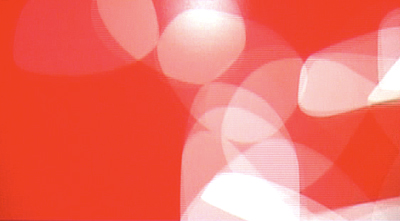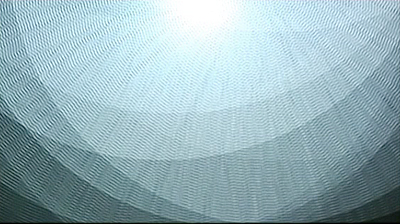
Fondation Cartier. Paris 2005. © John Maeda

Fondation Cartier. Paris 2005. © John Maeda

Fondation Cartier. Paris 2005. © John Maeda
John Maeda’s first ever exhibition in Europe took place in november 2005, Paris. His huge ‘motion paintings’ were exhibited in the large downstairs hall at La Fondation Cartier. This space gave ample view of each piece. However, there was an essential dimension that seemed to be missing.
The visual impact of Maeda’s motion paintings presents the viewer with sufficient abstraction amongst the various forms and colours to engage one in a vast array of interpretations. The particular finesse of each image would suffice in static form, so to view them in movement is quite spectacular. And this was where I stumbled upon my thoughts. The added dimension of motion gave a wonderfully rhythmic quality to the works and I immediately felt a sonic connection. The play on polyphony, tone, rhythm and even timbre, graphically depicted upon these screens, conjured up an imaginary soundscape within my head. Why hadn’t Maeda added music to his works?
Apart from the actual layout of the large screens, seven in total, making it virtually impossible to have sound amplified for each in such a space, there was a perfectly understandable explanation for the lack of sound. Maeda pointed out to me that each piece was an ‘interpretation’ of some kind of data. Collecting as well as organizing this data, Maeda had designed and written various code-based systems which enabled him to interpret vast amounts of information in a visual and artistic context. One particular piece for example had gathered information using Google’s search engine, this data was then used as a kind of raw material with which to ‘paint the canvass’. Sound therefore was not a part of the work.
If we look at the development of motion paintings, the artists at the beginning of the 20th Century were experimenting directly with this relationship between sound and image. Music had become not only an inspirational source, it was at times the very basis of the visual work. Norman McLaren’s Synchromy is a perfect example and Oskar Fischinger devoted his whole life to what has been named ‘visual music’. Nowadays it appears that we have come full circle. Many artists are turning to music and musicians to art. The two mediums have been mastered in technical terms. With the birth of home computing and dedicated audiovisual software, the artist has ultimate control over image and sound. Each pixel or grain of sound can be manipulated on a micro level.
What Maeda has accomplished and what appears to be becoming an increasing trend for future artists, designers and musicians is drawing from the bottomless well of information, in terms of data, that surrounds us today. Whether it be to create for creation’s sake or to organize that information for meaningful design objectives, information is being fed into new systems of visual, sonic and interactive possibilities. This is not to say however that the relationships between sound and image have been exhausted as a source of inspiration.
Robert Hodgin of the Barbarian design group uses the software Processing as a means to develop interactive design systems. Robert already has a variety of quality design work to his portfolio and one of his most coveted projects appears to be in sonic visuals. Taking rhythm, pitch and timbre as the basic data, he feeds his home grown systems with this musical information to create some of the freshest visuals to have adorned our screens in the motion arena for a long while.
John Maeda
Barbarian Group
Robert Hodgin

Leave a comment